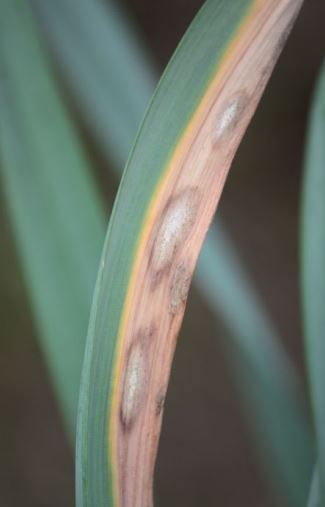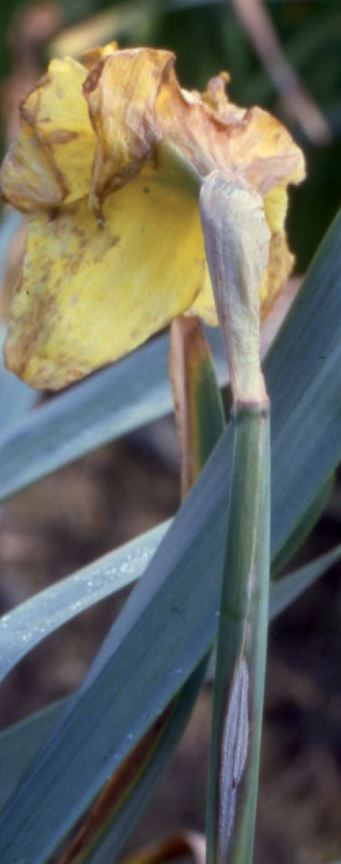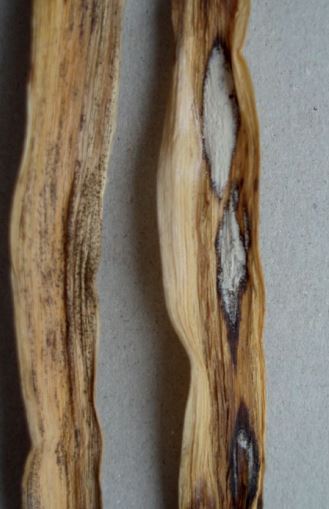Please click here to access the main AHDB website and other sectors.
- Home
- Knowledge library
- Narcissus white mould: symptoms, spread and disease development
Narcissus white mould: symptoms, spread and disease development
Find information on white mould, caused by the fungus Ramularia vallisumbrosae, and how it develops on and affects narcissus
The information was last updated in 2016.
Go back to the main page: Narcissus leaf scorch, smoulder and white mould
Caused by the fungus Ramularia vallisumbrosae, white mould used to be primarily a disease of Southwest England, South Wales and Southwest Scotland. Nowadays if you are growing narcissus, you need to know how to identify and control the disease no matter where you are. White mould now occurs regularly in the main narcissus growing regions including Cornwall, Eastern England and Northeast Scotland and it causes significant crop damage if not adequately managed. It is also reported as an increasing problem in the Republic of Ireland.
Spotting the symptoms
White mould appears initially as small, slightly sunken, grey-green or yellowish spots or streaks near the leaf tip. These increase in size to form yellowish-brown oval lesions (see figure 1).
 ADAS
ADAS
Figure 1. White mould leaf lesions showing a powdery, white spore mass in the central areas
Early crops
In early crops in the south west these may appear as early as January, soon after leaf emergence. In wet or humid weather, a powdery white mass of spores develops within the central area of the lesion.
Further lesions develop on both leaves and flower stems (see figure 2), often coalescing to cause rapid leaf dieback.
Roughly circular patches of dead foliage, several metres in diameter, frequently occur in affected crops.
Later in the season, small dark resting bodies (sclerotia), around 0.1mm in diameter, develop within affected areas of leaves and stems.
 ADAS
ADAS
Figure 2. White mould flower stem infection
Epidemic
In warm, wet springs the disease becomes an epidemic and causes the leaves to die down early.
The loss of green leaf area and early senescence cause a considerable reduction of bulb size and potential flowers for the next season.
Sources and spread
There is no evidence that R. vallisumbrosae is carried on bulbs and initial outbreaks each year are believed to originate from the minute black sclerotia that survive the summer in leaf debris (see figure 3).
These germinate in the winter, usually from December to March, to produce dispersal spores (mainly scolecospores) which can infect the new leaves as they emerge.
The fungus may attack leaves and flower stalks a few centimetres below ground level but bulbs are not attacked.
Spores are spread from the white powdery fungal mass on leaf lesions by wind and water-splash to cause further leaf and flower stalk infections.
 ADAS
ADAS
Figure 3. White mould sclerotia in leaf debris; small black sclerotia are just visible on the upper mid-section of the lower leaf
Causes and development
Experimental work showed the optimum temperature for germination of sclerotia in winter/spring was 5–10°C; water was also required.
The optimum climatic conditions for infection by spores arising from sclerotia and white mould affected leaves were a temperature of 5–10°C and leaf wetness of 12–14 hours’ duration.
As with B. narcissicola, damage is required for rapid development of leaf lesions to occur.
Preliminary investigations
Preliminary investigations have shown evidence that different spore types produced by white mould have different climatic criteria for their formation.
In warm, wet springs the disease can become an epidemic, causing leaves to die down early, but in cool, dry weather the spores cannot survive for long, the disease is checked and spore formation prevented.
Observations suggest wind-blown rain is important for epidemic development, with field boundaries sometime acting as a barrier to disease spread.

